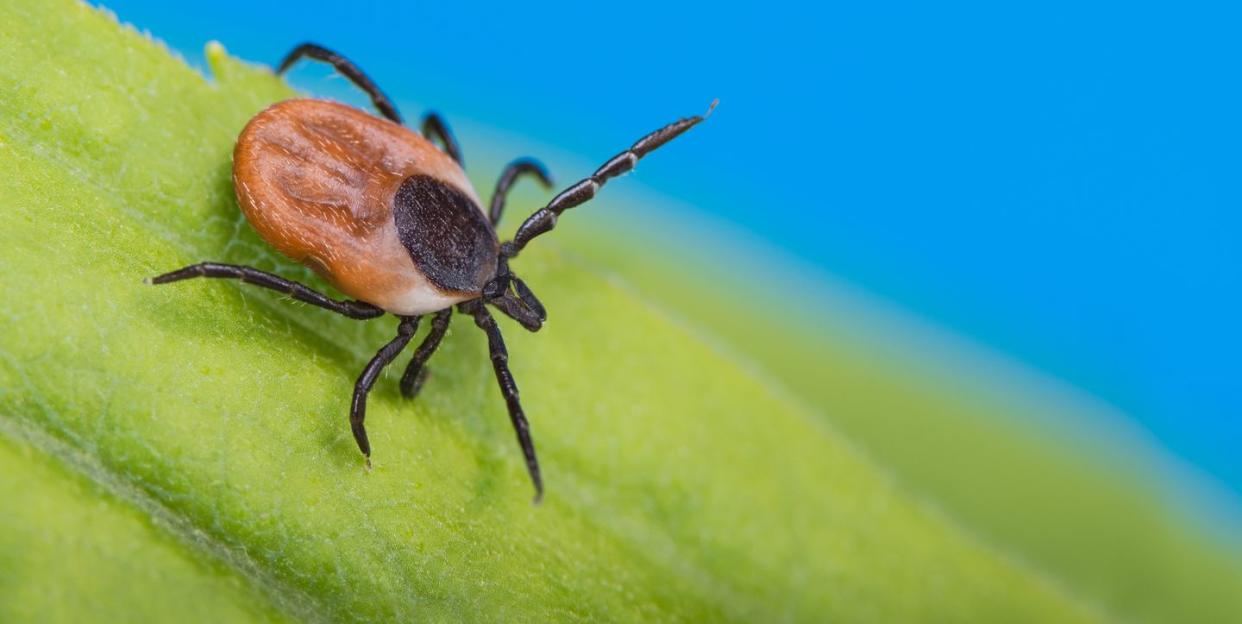Lyme-Carrying Ticks Are Abundant Right by the Beach, Study Finds. Here’s How to Stay Safe.

A new study found that blacklegged ticks were just as common in beach grass and vegetation leading to the sand as wooded areas in Northern California.
The beach ticks were also slightly more likely to carry the bacteria that causes Lyme disease than those found in the woods, the researchers found.
Experts explain where you can encounter ticks at the beach and how to stay safe this summer.
It’s rare to feel any worries while you’re at the beach—you’re probably there to relax, after all. But if anything is bound to put a damper on your day, it’s the possibility of a rogue jellyfish or a feisty crab popping up when you least expect it, right?
Not so fast: New research suggests ticks should be on your radar too—yes, those tiny, blood-sucking, disease-carrying bugs that typically infest grassy areas and forests.
A new study, which was funded by the Bay Area Lyme Foundation and published in the journal Applied and Environmental Microbiology, analyzed several sites and habitats in Northern California to identify the presence of blacklegged ticks.
“We were looking at coastal scrub and looked at redwood forests and oak woodlands and that kind of thing, because everyone tends to look at the same kinds of places,” Daniel Salkeld, Ph.D., the study’s lead author and a research scientist at Colorado State University told The Washington Post. “And we found ticks pretty much wherever we looked.”
The most surprising finding? They discovered as many ticks that carried Borrelia burgdorferi—the bacteria that causes Lyme disease—in beach grass and areas leading to the sand as they did in wooded areas in other parts of the state. Plus, the beach ticks were slightly more likely to carry the bacteria that causes Lyme disease than those in the woods (4.1% compared to 3.9%).
So, how concerned should you be about the possibility of encountering one of these poppyseed-sized pests during your beach day? Here’s what you need to know to stay safe this summer, according to experts.
Where can you find ticks at the beach?
You’re unlikely to find a tick hanging out in the middle of the sand next to your beach blanket. “That environment would be too hot and dry for ticks to survive,” explains Nancy Troyano, Ph.D., a board-certified entomologist and Director of Operations Education and Training for Ehrlich Pest Control.
Alvaro Toledo, Ph.D., assistant professor of entomology at Rutgers University in New Jersey, agrees. “Ticks are typically found in their preferred host habitat, so those species found in coastal ecosystems are there because there are host—blood meals—present,” he says. (Yeah, gross.)
Instead, ticks near the beach prefer to stick to areas with more foliage, like dunes covered in beach grass or brushy pathways to the sand, says Howard Russell, M.S., an entomologist at Michigan State University.
How to avoid ticks at the beach
The best thing you can do is be mindful of your surroundings. “Just be aware of the possibility and perform tick checks before getting into the car and again upon arriving back home,” Russell says.
The standard tick bite prevention methods (beyond applying a repellent), like wearing pants and long sleeves and tucking your pants into your socks, don’t really work at the beach. Instead, pay close attention to how you’re entering the area. If you can, it’s best to avoid walking through grassy and brushy patches that border the sand.
“This is where ticks can latch onto you or any beach bag or towels that you are carrying if those items contact the vegetation,” Troyano says. “Many beaches have entrances or walkways to the sand. Stay on those walkways to enter.”
Keep children or pets out of these tick-harboring areas too, says Russell, as they can easily carry them home.
If you do have to walk through brush or grass, check yourself for ticks immediately after. “Especially with Lyme disease, it’s important to find those ticks as soon as possible to reduce the chance of transmission,” says Ben Hottel, Ph.D., a technical services manager at Orkin. To do this, make sure you closely examine under your arms, in and around your ears, inside your belly button, behind your knees, in and around your hair, between your legs, and around your waist, per the Centers for Disease Control and Prevention (CDC).
What to do if you find a tick on your body
The CDC has pretty specific instructions on how to remove a tick correctly. Here’s what to do if you happen to find one latched onto on you:
Use fine-tipped tweezers to grasp the tick as close to your skin’s surface as possible.
Pull upward with steady, even pressure. (Don’t twist or jerk the tick—this can cause the mouth-parts to break off and remain in the skin.)
After removing the tick, clean the bite area and your hands well with rubbing alcohol or soap and water.
Dispose of the tick by putting it in alcohol, placing it in a sealed bag/container, wrapping it tightly in tape, or flushing it down the toilet. (Many prefer to save the tick, just in case it needs to be tested.)
You’ll also want to monitor yourself for signs of Lyme disease, the most common tick-borne illness in the U.S. If you experience any of the following symptoms after a tick bite, call your doctor:
Fever
Chills
Headache
Fatigue
Muscle and joint aches
Swollen lymph nodes
A rash that may look like a bulls-eye around the site of the bite
Go here to join Prevention Premium (our best value, all-access plan), subscribe to the magazine, or get digital-only access.
You Might Also Like

